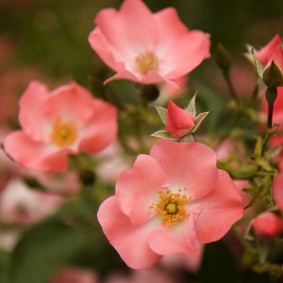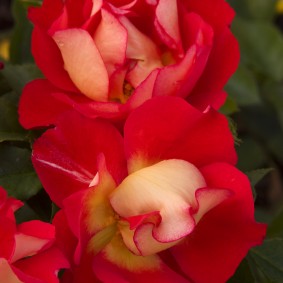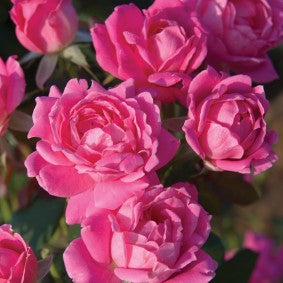 More roses are sold the week leading up to Mothers Day that rivals Valentines. Mothers do enjoy a dozen long stem roses on her big day, but just as quickly forgotten days later when they hit the dumpster. Why not give the gift of a new rose bush for mom this year? Mothers Day is the peak of the planting season; with the planting of just one bush dozens upon dozens of roses can be enjoyed this year.
More roses are sold the week leading up to Mothers Day that rivals Valentines. Mothers do enjoy a dozen long stem roses on her big day, but just as quickly forgotten days later when they hit the dumpster. Why not give the gift of a new rose bush for mom this year? Mothers Day is the peak of the planting season; with the planting of just one bush dozens upon dozens of roses can be enjoyed this year.
Roses are easier to grow at this altitude than other parts of the country. High mountain roses are less likely to have trouble with mildew and rarely have black spot issues which plague roses in other parts of the country. Our roses have some issues with bugs, but easily controlled.
There are literally thousands of named roses, each has its purpose. Roses are grown for cut flowers, screens, borders, hedges, ground covers, wall covers, for use in containers, and as specimen plants. Though all roses are closely related to one another, each type has its defining characteristics. It’s easy to find a type that suits your tastes and meets the requirements of your landscape.
Hundreds of roses have begun their summer bloom here at the garden center. There are seven main rose categories defined for different parts of the landscape.
- Shrub Rose – the term shrub covers a variety of roses, from bushy specimens to hedge roses. Generally, hardy and disease resistant, shrub roses provide a lot of blooms. Size varies with the variety, and heights range from three to ten feet or more. The Knockout rose is jewel of the shrub roses because it requires little pruning and continually produces flowers.
- Hybrid teas – are the most widely grown roses. Their traits include large single blooms on long stems with the best shows in spring and fall. If you receive a Mother’s Day rose, it’s probably a hybrid tea. These roses are ideal for cutting as most bloom steadily during the entire growing season. Hybrid teas grow three to six feet tall and need at least six hours of sun for best performance.
- Floribundas – blooms are slightly smaller than those of a hybrid tea and they appear in clusters on the stem. You don’t have to speak Latin to know that the “bunda” part means abundance, referring to this variety’s many stems loaded with flowers and its longer bloom cycle. If you want to add an abundance of color to your landscape, the floribunda is the rose for you. Its height is generally three to five feet tall.
- Grandifloras – are a cross of the hybrid tea and the floribunda. Like floribundas, they usually have several clustered blooms on each stem. However, from the hybrid teas, they have inherited larger blooms and longer steins, Grandifloras can grow to a height of six feet.[youtube]https://www.youtube.com/watch?v=oqM4B-S6dlQ[/youtube]
- Climbers – also called ramblers, climbing roses don’t really climb. These plants produce long arching canes that must be attached to supports such as fences, arbors, trellises or walls. They bloom continuously or at least several times during summer and fall. The arching canes can be 20 to 30 feet long; so if your garden space is limited but you want to plant some of these “climbing” wonders, use vertical space to fit them into your landscape.
- Ground Covers – are among my favorite plants to use in containers and flower beds. Any variety of spreading or low growing rose used for covering banks or planting between taller shrubs fits this category. These short roses are no more than knee high. They are welcome additions to gardens because of their repeat flowering and good resistance to disease.
- Trees – not truly a separate rose variety, a tree rose is any rose plant (probably a hybrid tea or floribunda) that is grafted onto a straight sturdy trunk. This variety is not for the novice gardener because of the special pruning and winter protection it requires. Tree roses make good container plants that bring a formal look to the garden.
When shopping for roses remember to check for the following characteristics:
- Size is a key consideration when planting. Most roses will reach their full growth in two to three years. When planning a rose bed or adding roses to the garden, size is an important factor in determining placement so that blooms will be readily visible.
 Bloom times and frequency of bloom periods vary. Hybrid teas and floribundas are usually repeat bloomers and should bloom through November or until the first hard freeze. Roses with a single bloom cycle have one showy mass of flowers each season.
Bloom times and frequency of bloom periods vary. Hybrid teas and floribundas are usually repeat bloomers and should bloom through November or until the first hard freeze. Roses with a single bloom cycle have one showy mass of flowers each season.- Fragrance is a trait we all associate with roses, which can have some of the most delicious fragrances in the world of flowers. Some roses have little scent at all, others are known for their intoxicating fragrances. Humidity and warmth bring out fragrance, which is a reason May is the start of rose season. Because smell is a subjective thing, what is heavenly to some may be sickening to others. “Let your nose pick the rose!”
Roses have very deep roots; so they should be added to the drip system that is watering your trees and other shrubs. A good deep soak once a week should produce roses that send up continual color throughout the season.
Until next week, I’ll see you in the garden center.
Ken Lain can be found throughout the week at Watters Garden Center, 1815 W. Iron Springs Rd in Prescott, or contacted through his web site:www.wattersgardencenter.com or Watters Garden Center Facebook page.
Share this garden column with friends and family. Free email delivery.
Share with your friends on Facebook
Retweet to your followers


